被动语态导学案
2025年人教版英语九年级英语中考被动语态导学案
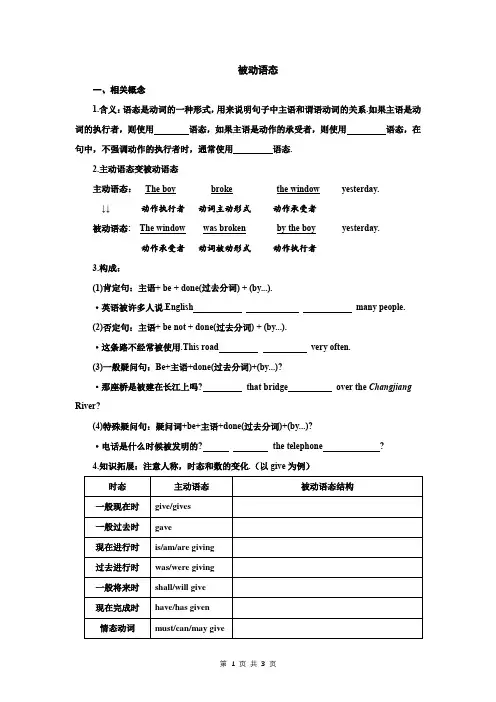
被动语态一、相关概念1.含义:语态是动词的一种形式,用来说明句子中主语和谓语动词的关系.如果主语是动词的执行者,则使用语态,如果主语是动作的承受者,则使用语态,在句中,不强调动作的执行者时,通常使用语态.2.主动语态变被动语态主动语态:The boy broke the window yesterday.↓↓ 动作执行者动词主动形式动作承受者被动语态: The window was broken by the boy yesterday.动作承受者动词被动形式动作执行者3.构成:(1)肯定句:主语+ be + done(过去分词) + (by...).·英语被许多人说.English many people.(2)否定句:主语+ be not + done(过去分词) + (by...).·这条路不经常被使用.This road very often.(3)一般疑问句:Be+主语+done(过去分词)+(by...)?·那座桥是被建在长江上吗? that bridge over the Changjiang River?(4)特殊疑问句:疑问词+be+主语+done(过去分词)+(by...)?·电话是什么时候被发明的? the telephone ?4.知识拓展:注意人称,时态和数的变化.(以give为例)时态主动语态被动语态结构一般现在时give/gives一般过去时gave现在进行时is/am/are giving过去进行时was/were giving一般将来时shall/will give现在完成时have/has given情态动词must/can/may give二、主动语态变被动语态的几种特殊情况和注意事项:1.主动形式表示被动含义(主表被)①动词(表示主语的属性特征)+副词(well/badly/easily...),当他们与相应的副词连用的时候用主动表示被动.此类动词有:write, sell, clean, wash等词作不及物动词时,如:The book sells well.·这种食物尝起来好卖的也好. This food tastes and well.·这支笔写的很糟/很流畅. This pen badly/smoothly.·这家商店八点营业. The shop at 8 AM.②want/need + doing 相当于want/need + to be done.·你的衣服需要洗. Your clothes need . = Y our clothesneed .③在be worth doing中,doing表被动意义.·This book is worth .(read) ·This stamp is worth .(collect)2.feel, listen to, hear, let, make, have, see, look at, watch, notice动词后作宾补的不定式都不带to;但改成被动语态后必须带to.(to还原)·The boss made him work all day. He all day(by the boss).·I often hear her sing this song. She often this song(by me).3.动词短语变为被动语态时,不能丢掉动词后的介词或者副词. 【介不丢】·She takes care of the baby every day. The baby by her every day.·People should speak to the old politely. The old politely by people.小练笔:This dictionary mustn’t the library.A. take awayB. be taken awayC. be taken away from4.用于词组的被动语态,常用于表示“据说”或者“相信”,例如:It is said that... (据说) It is reported that... (据报道) It is well-known that... (众所周知)5.含有情态动词的被动语态主语+情态动词+be+动词的过去分词(+by+动作执行者)·他能够被找到. can by .·指南针可以在任何天气中被使用.The compass in any weather.6.含双宾语的主动结构变为被动结构时:(1)将宾语变为主语,宾语保持不变.·He told us a story → were a story by .(2)将宾语变为主语,宾语用介词to/for引导.·He told us a story → told us by him.·Her mother gave her a new pen. →A new pen her by her mom.知识巩固:填介词(to/for)explain/bring/give/lend/offer/pass/sell/send/show/take/teach/tell/write/return/serve sth. sb.design/build/buy/cook/do/draw/make/order/choose/find/get/prepare sth. sb.7.不用于被动语态的情况(1)不及物动词无被动语态.如:appear, die, end, fail, happen, sit, stand, come true, fell asleep, take place等.小练笔:Great changes in the last 3 years.A. have taken placeB. have been taken placeC. have happened·昨天这个城镇发生了一场事故. An accident in this town yesterday.(2)系动词无被动语态.如:be, become, feel, get, grow, keep, look, seem, smell, sound, stay, turn等.·它听起来很好。
被动语态导学案
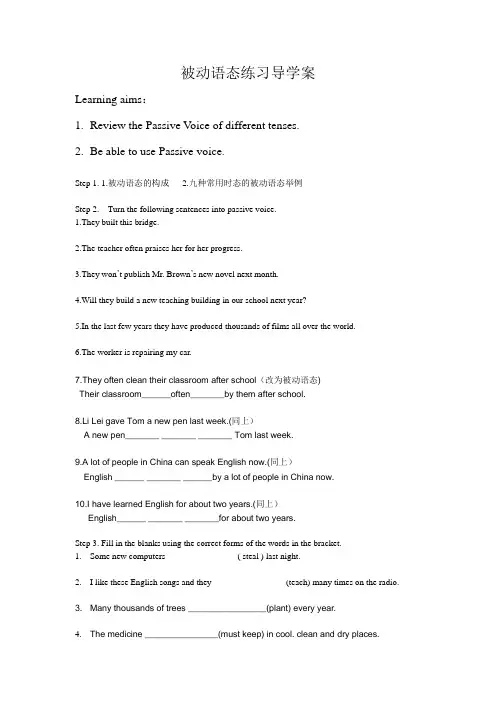
被动语态练习导学案Learning aims:1.Review the Passive V oice of different tenses.2.Be able to use Passive voice.Step 1. 1.被动语态的构成 2.九种常用时态的被动语态举例Step 2. Turn the following sentences into passive voice.1.They built this bridge.2.The teacher often praises her for her progress.3.They won’t publish Mr. Brown’s new novel next month.4.Will they build a new teaching building in our school next year?5.In the last few years they have produced thousands of films all over the world.6.The worker is repairing my car.7.They often clean their classroom after school(改为被动语态)Their classroom______often_______by them after school.8.Li Lei gave Tom a new pen last week.(同上)A new pen_______ _______ _______ Tom last week.9.A lot of people in China can speak English now.(同上)English ______ _______ ______by a lot of people in China now.10.I have learned English for about two years.(同上)English______ _______ _______for about two years.Step 3. Fill in the blanks using the correct forms of the words in the bracket.1.Some new computers ________________( steal ) last night.2.I like these English songs and they ________________ (teach) many times on the radio.3. Many thousands of trees ________________(plant) every year.4.The medicine _______________(must keep) in cool. clean and dry places.5..When and where to build the new factory __________________(not decide) yet.6. 6. .Please wait a minute. Your bike __________________(mend) now.Step 4. 用动词的正确时态、语态填空:Our desks and chairs _____________ (make) of wood. The paper of books and newspapers _____ also _______ (make) from wood. Even some kinds of cloth __________ (make) from it. Many people _______ (burn) wood to keep themselves warm in winter. Indeed, wood ______(be) important in our everyday life.Where______ wood ________(come) from? It __________ (take) from trees which ________(grow) in the mountains. _____ you _______ (know) how it _____ (get) to us from the mountains?First of all, trees________(cut) down when they _____________(grow) big enough. Then their branches __________ (cut) off, and logs___________(make).These heavy logs __________(put) together in different ways and ______ (take) down to the foot of the mountains. Some of them _________ (float使漂流) down the small rivers and others___________ (carry) down on trains.Big trees ___________(cut) down in the mountains every year. Then young ones _______________ (must, plant) so that we ______ always______ (can, have) enough wood. We have to take good care of mountains so that they _____ always ________ (may, cover) with growing trees.Step 5.Translate the following sentences:1.台湾属于中国.2.韩寒的书很畅销.3.这录音机不转.4.火灾是怎样发生的?5.这个问题值得讨论.6.这种布摸起来很柔软.Step 6. Summing upStep 7. Homework:Complete all the exercises Typed in the paper.。
被动语态导学案
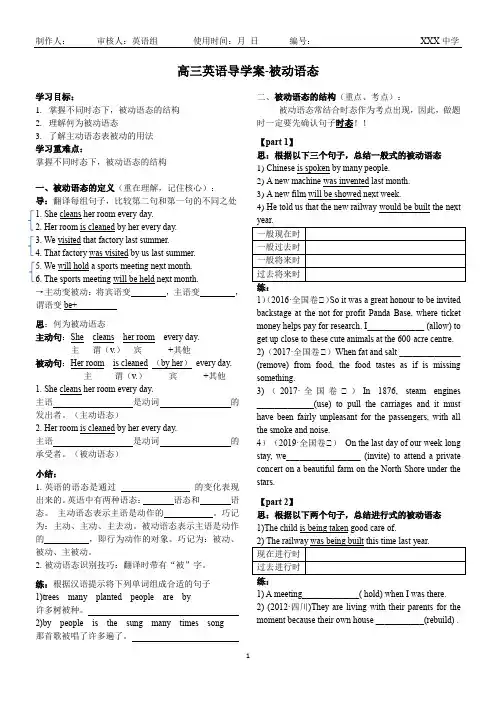
高三英语导学案-被动语态学习目标:1. 掌握不同时态下,被动语态的结构2. 理解何为被动语态3. 了解主动语态表被动的用法 学习重难点:掌握不同时态下,被动语态的结构一、被动语态的定义(重在理解,记住核心): 导:翻译每组句子,比较第二句和第一句的不同之处 1. She cleans her room every day. 2. Her room is cleaned by her every day. 3. We visited that factory last summer. 4. That factory was visited by us last summer.5. We will hold a sports meeting next month.6. The sports meeting will be held next month.→主动变被动:将宾语变 ,主语变 , 谓语变be+思:何为被动语态主动句:She cleans her room every day. 主 谓(v.) 宾 +其他被动句:Her room is cleaned (by her ) every day. 主 谓(v.) 宾 +其他 1. She cleans her room every day.主语 是动词 的发出者。
(主动语态)2. Her room is cleaned by her every day.主语 是动词 的承受者。
(被动语态)小结:1. 英语的语态是通过 的变化表现出来的。
英语中有两种语态: 语态和 语态。
主动语态表示主语是动作的 。
巧记为:主动、主动、主去动。
被动语态表示主语是动作的 ,即行为动作的对象。
巧记为:被动、被动、主被动。
2. 被动语态识别技巧:翻译时带有“被”字。
练:根据汉语提示将下列单词组成合适的句子1)trees many planted people are by许多树被种。
《被动语态》 导学案
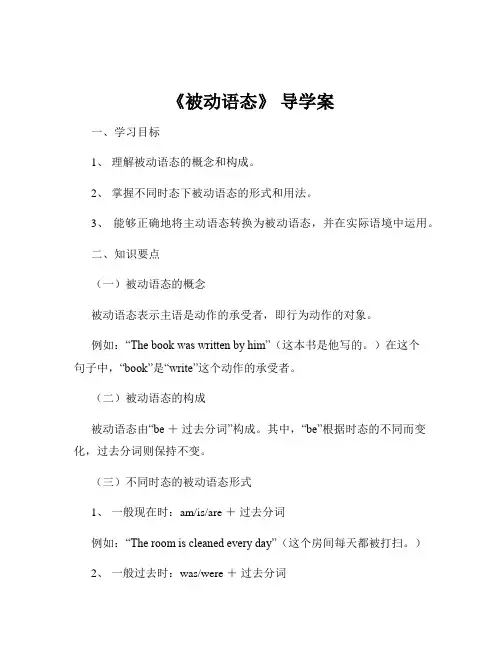
《被动语态》导学案一、学习目标1、理解被动语态的概念和构成。
2、掌握不同时态下被动语态的形式和用法。
3、能够正确地将主动语态转换为被动语态,并在实际语境中运用。
二、知识要点(一)被动语态的概念被动语态表示主语是动作的承受者,即行为动作的对象。
例如:“The book was written by him”(这本书是他写的。
)在这个句子中,“book”是“write”这个动作的承受者。
(二)被动语态的构成被动语态由“be +过去分词”构成。
其中,“be”根据时态的不同而变化,过去分词则保持不变。
(三)不同时态的被动语态形式1、一般现在时:am/is/are +过去分词例如:“The room is cleaned every day”(这个房间每天都被打扫。
)2、一般过去时:was/were +过去分词例如:“The tree was cut down yesterday”(这棵树昨天被砍倒了。
)3、一般将来时:will be +过去分词或 be going to be +过去分词例如:“The meeting will be held next week”(会议将在下周举行。
)4、现在进行时:am/is/are being +过去分词例如:“The problem is being discussed now”(这个问题正在被讨论。
)5、过去进行时:was/were being +过去分词例如:“The house was being built at that time”(那时候房子正在被建造。
)6、现在完成时:have/has been +过去分词例如:“The work has been finished”(工作已经完成了。
)7、过去完成时:had been +过去分词例如:“The task had been completed before he came”(在他来之前任务已经完成了。
被动语态导学案
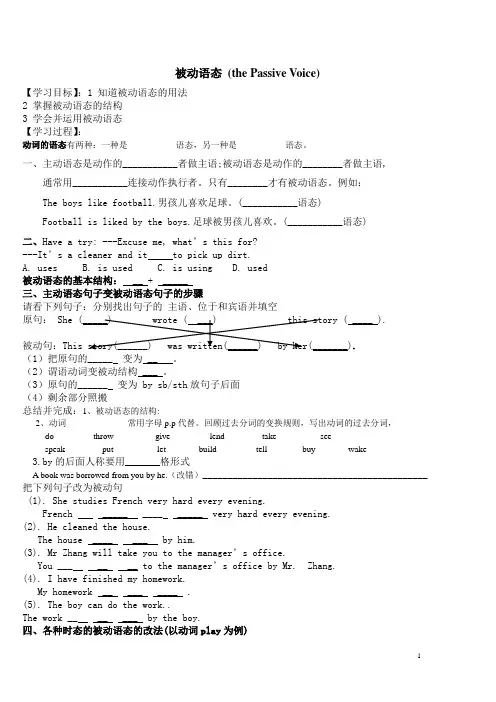
被动语态(the Passive Voice)【学习目标】:1 知道被动语态的用法2 掌握被动语态的结构3 学会并运用被动语态【学习过程】:动词的语态有两种:一种是___________语态,另一种是___________语态。
一、主动语态是动作的___________者做主语;被动语态是动作的________者做主语,通常用___________连接动作执行者。
只有________才有被动语态。
例如:The boys like football.男孩儿喜欢足球。
(___________语态)Football is liked by the boys.足球被男孩儿喜欢。
(___________语态)二、Have a try: ---Excuse me, what’s this for?---It’s a cleaner and it to pick up dirt.A. usesB. is usedC. is usingD. used被动语态的基本结构: __ + _____三、主动语态句子变被动语态句子的步骤请看下列句子:分别找出句子的主语、位于和宾语并填空原句:被动句:(1)把原句的_____ 变为 __ 。
(2)谓语动词变被动结构 ___ 。
(3)原句的______ 变为 by sb/sth放句子后面(4)剩余部分照搬总结并完成:1、被动语态的结构: ______________2、动词______________常用字母p.p代替。
回顾过去分词的变换规则,写出动词的过去分词,do ________ throw_________ give ________ lend________ take _________ see ________speak________ put _________ let_______ build ________ tell _______ buy _______wake________3.by的后面人称要用_______格形式A book was borrowed from you by he.(改错)_____________________________________________ 把下列句子改为被动句(1). She studies French very hard every evening.French _____ ____ _____ very hard every evening.(2). He cleaned the house.The house ____ ___ by him.(3). Mr Zhang will take you to the manager’s office.You ___ __ __ to the manager’s office by Mr. Zhang.(4). I have finished my homework.My homework __ ___ ____ .(5). The boy can do the work..The work __ __ ___ by the boy.四、各种时态的被动语态的改法(以动词play为例)规律总结:__________________________________________________五、考点指导1 、如果主动句带双宾语,变为被动句时,将其中一个宾语变为主语,另一个________。
被动语态 导学案 10.16
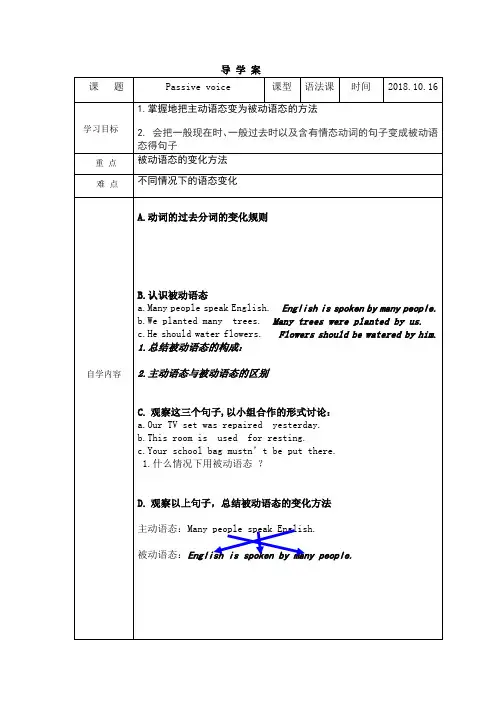
学习)
(一)归纳练习:小组合作将下列句子变为被动语态
1.They play football on Sunday.
2.They often use computers in class.
3.We make these machines in Beijing.
总结:一般现在时被动语态的结构:
(二)归纳练习:小组合作将下列句子变为被动语态
2.Lucy may draw the pictures.
3.You must turn off the lights.
总结:情态动词被动语态的结构:
自学困惑
及
自主质疑
被动语态:English is spoken by many people.
自学方法
自学法,小组讨论法
自学时间
2018.10.15
自学要求
1.仔细阅读课本150页的内容,同时可通过上网搜索或查阅参考书以及小组讨论等方式进行自学。
2.在预习中遇到的,组内没解决的问题,可出示在各自的白板上。
基ቤተ መጻሕፍቲ ባይዱ性
问题
探究
a.Our TV set was repaired yesterday.
b.This room is used for resting.
c.Your school bag mustn’t be put there.
1.什么情况下用被动语态?
D.观察以上句子,总结被动语态的变化方法
主动语态:Many people speak English.
1.He bought a bike yesterday.
2.The policeman caught a thief last week.
被动语态的导学案
被动语态的导学案一、学习目标1、理解被动语态的基本概念和用法。
2、掌握被动语态的不同形式。
3、能够在语境中正确使用被动语态。
二、学习内容1、被动语态的定义和构成被动语态是一种表示主语被动作的语态,通常由助动词be和动词的过去分词组成。
例如,The book was written by him.(这本书被他写了。
)2、被动语态的不同形式被动语态有许多不同的形式,包括现在时、过去时、完成时等。
这些形式可以用来表达不同的时态和语态。
例如,现在时的被动语态为“am/is/are +过去分词”,过去时的被动语态为“was/were +过去分词”,完成时的被动语态为“have/has + been +过去分词”。
3、被动语态的用法被动语态可以用来表达以下情况:a)主语是动作的接受者。
例如,“The car was hit by a bus.”(汽车被公交车撞了。
)b)不知道或不需要知道动作的执行者。
例如,“The book was written in 1990.”(这本书在1990年被写了。
)c)为了强调动作的接受者。
例如,“The building was destroyed in the earthquake.”(这座建筑在地震中被毁了。
)三、学习活动1、阅读课文并回答问题阅读课文中关于被动语态的部分,并回答以下问题:a)什么是被动语态?b)被动语态有哪些不同的形式?c)被动语态在什么情况下使用?2、做练习题完成课文中的练习题,包括填空题、选择题和翻译题等,以检验自己对被动语态的理解和掌握程度。
3、小组讨论和交流与小组成员讨论和交流,分享彼此对被动语态的理解和经验,并一起解决学习中遇到的问题。
4、总结和反思回顾学习内容,总结重点和难点,反思自己的学习成果和不足之处,并制定改进计划。
四、学习成果评估1、课堂表现评估在课堂上积极参与讨论和回答问题,表现出对被动语态的理解和掌握程度。
2、作业评估按时完成作业,包括课文中的练习题和其他相关练习,以检验自己对被动语态的掌握程度。
被动语态 导学案
被动语态导学案Ⅰ. 学习目标:知识目标:通过本课学习与练习, 全体学生能够准确找出含有被动语态的句子并总结出被动语态的构成方式(be+动词过去分词);大多数学生能够通过be的变化正确运用一般现在时、一般过去时、一般将来时及含有情态动词的被动语态谈论“被做的事”。
多数学生能够运用被动语态描述家乡的变化。
能力目标:1.多数学生能够通过观察与合作学习,分析并总结出被动语态的用法,并能比较准确地对三种时态及含有情态动词的被动语态进行判断和运用。
2.通过本课中的学习活动,程度较好的学生能够发展综合运用语言的能力;程度较弱的学生能够运用所学知识进行简单运用。
情感态度:经过本课的学习,所有学生能够树立合作意识及竞争意识。
Ⅱ. 重点、难点:重点:被动语态的构成方式(be+动词过去分词);一般现在时、一般过去时、一般将来时及含有情态动词的被动语态的用法。
难点:被动语态中be的变化(时态、单复数)。
Ⅲ. 课前预习:一、请从Unit 5 Par tⅠ的听力材料中找出含有被动语态的句子并写在下面的横线上(见投影)。
二、观察以上句子的动词形式,试着总结出被动语态的构成方式。
思考:该构成方式中哪个词会有变化呢?会有什么变化?你能运用该构成方式及其变化写句子吗?Ⅳ. 课堂学习:一、通过预习活动导入学习内容.二、运用被动语态口头造句.三、总结被动语态用法,完成下面表格。
Ⅴ.练习:一、用所给动词及时间,运用被动语态描述图片(见投影)。
1. build, in 20052. write, Lu Xun3. trees, plant, every year/last year/ next year4. clean, yesterday/every afternoon/this afternoon5. must, read, every day,二、小组竞赛活动,运用被动语态描述图片(用尽可能多的动词及时态)三、Writing: 我的家乡近几年变化很大,请根据图片及提示词,以Changes in myhometown 为题,写一篇关于家乡变化的文段,并表达你对此的感受。
被动语态导学案
被动语态导学案课题被动语态学习目标与考点分析学习目标:熟练掌握被动语态的用法,特别是常用时态的被动语态和情态动词被动语态;熟练掌握主动形式表示被动意义用法。
考点分析:被动语态为初中英语语法重点和难点,是历年中考必考知识点。
学习重点被动语态与时态结合用法;主动表被动用法。
学习方法讲练结合讲问结合教学步骤提前预习、自主学习、问题探究、展示交流、问题生成、处理练习、谈论收获/反思学习内容与过程提前预习一、英语中的语态1)主动语态和被动语态:英语动词有两种语态,即主动语态(The Active V oice)和被动语态(The PassiveV oice)。
主动语态表示主语是动作的执行者,被动语态表示主语动作的承受者。
如:Many students study English.(主动语态)English is studied by many students.(被动语态)2)被动语态的结构:被动语态由“助动词be+及物动词的过去分词”构成,助动词be有人称、数的变化,其变化规则与be作为连系动词时一样。
自主学习二、被动语态be + 过去分词(及物动词)被动语态是英语动词的一种特殊形式. 汉语中往往用“被”“受”“给”等词来表示被动意义.主动语态变为被动语态的方法:1 . 主动句中的宾语变成被动句的主语.2 . 主动句中的谓语动词变成被动句的be + 过去分词.3 . 主动句中的主语变成被动句by的宾语, 放在谓语动词后面. 如果不强调动作执行者时, by 短语可省略.例句1.He plants trees in spring.2.His brother washes bowls every day.3.Tom cleans the room every week.问题探究主动语态变为被动语态1.They make shoes in that factory.(主语+及物动词+宾语)2. They bought ten computers last term.3. Amy can take good care of Gina .三、常用的被动语态结构时态结构一般现在时am/is/are+p.p.一般过去时was/were+p.p.注意:情态动词的被动语态结构为:情态动词+be+过去分词问题生成四、主动语态变成被动语态时要注意以下几点:1 . 含有双宾语的主动句变成被动句时, 可以将其中一个宾语变为主语, 另一个不动. 一般把间接宾语变为主语.如: Mary gave me a pen .I was given a pen by Mary .如果把直接宾语变为主语, 则在间接宾语前加“ to \for”如: A pen was given to me by Mary .2 .含有复合宾语的主动句变为被动句时, 将其中的宾语变为主语, 宾补不变.如: We asked him to speak at the meeting .He was asked to speak at the meeting .3 . 如果主动句中的谓语是短语动词, 变为被动句时, 短语动词的介词或副词不可以丢掉.如: They took good care of the boys .The boys were taken good care of .4 . 在“ let , make , see , hear , notice , watch , feel ”等动词后面做宾语补足语的动词不定式不带“ to ” , 但改成被动句时应加上“ to ” .如: The doctor made me stay in bed for three days . I was made to stay in bed for three days by the doctor . 课堂训练:1 . He tells us a story every evening .2. He bought me a new bike yesterday.3 . Can he take his sister to the park ?4 . He found out the lost key .5. The boss made him do the heavy work.6. We often hear him play the guitar.五、不用被动语态的动词:1. 不及物动词(vi.) 如:happen, take place, appear, dissapear, …A traffic accident ________(happen) just now.2. 连系动词(Link.v.) 如:be, look, seem, feel, sound, smell, taste, get, turn,become…Peking Opera ________ (sound) beautiful.3. 当此动词表示事物的自然属性的时候:The pen _________ (write) very fast.This kind of sweater _______ (sell) well.课堂训练:1)Teenagers should _____ (allow) to go out at night.2)The telephone _____ (invent) by Bell.3) English ____ (speak) in China.4) The car ____ (make) in China.5) The room must _____ (clean) every day.课后反思:。
学习笔记整理 直述句改被动语态 导学案
学习笔记整理直述句改被动语态导学案研究笔记整理:直述句改被动语态导学案一、目的:本次研究笔记整理的目的是研究如何将直述句改写为被动语态。
被动语态在英语中的使用非常普遍,掌握这一技巧可以使我们的表达更加灵活和准确。
二、内容:1. 被动语态的构成:被动语态由助动词be加上过去分词构成,而且动作的执行者成为句子的主语。
2. 特殊情况的处理:a) 当直述句的主语是人,且我们想强调动作的承受者时,可以使用"by + 动作执行者"的形式。
b) 当直述句使用情态动词时,被动语态的构成中只需将情态动词后的动词原形改成过去分词。
3. 被动语态的应用:a) 当我们不知道或不关心动作的执行者时,可以使用被动语态。
b) 当我们想避免指责或责备某人时,也可以使用被动语态。
三、例句:1. 直述句:She wrote the letter.(她写了这封信。
)被动语态:The letter was written by her.(这封信是她写的。
)2. 直述句:They are building a new house.(他们正在建造一座新房子。
)被动语态:A new house is being built by them.(一座新房子正在被他们建造。
)3. 直述句:The students must finish their homework.(学生们必须完成他们的作业。
)被动语态:The homework must be finished by the students.(作业必须被学生们完成。
)四、总结:掌握将直述句改写为被动语态的技巧可以提升我们的英语表达能力,使句子更加地道和准确。
在使用被动语态时,需要注意特殊情况的处理和应用场景的选择。
以上是本次学习笔记整理的内容,希望对大家有所帮助!。
- 1、下载文档前请自行甄别文档内容的完整性,平台不提供额外的编辑、内容补充、找答案等附加服务。
- 2、"仅部分预览"的文档,不可在线预览部分如存在完整性等问题,可反馈申请退款(可完整预览的文档不适用该条件!)。
- 3、如文档侵犯您的权益,请联系客服反馈,我们会尽快为您处理(人工客服工作时间:9:00-18:30)。
被动语态导学案
学生自学一
一、写出人称代词(主格、宾格),并搭配be
二、根据要求,写出下列
visit(过去分词)carry(过去分词)see(过去分词)bought (原形) teach(现在分词)
三、互译下列动宾(V+O)词组
play the violin 种树
visit Baise 看电视
take photo 打篮球
学生自学二
五、将V+O动宾词组变为O+V宾动词组
V + O O + V
visit Baise -- ------ Baise visit
play the violin --------- the violin play
plant trees ---------
watch TV ---------
play football ---------
take photos ----------
学生自学三
六、用以上词组造句,请你试一试
S+V+O------------------ O+be+Ved +by +s
例子,1.We visit Baise.-------------- Baise is visited by us.
2. He plays the violin.------- The violin is played by him.
3. I watch TV.----------------- …
4.They play football.--------
5.She takes photos.----------
再一次归纳
一般现在时的结构:_____________ ----------- ______________________
七、主动和被动。
(观察以上左右两边的句子,如果说左边的句子都是主动句子,并叫做
主动语态。
那么,右边的句子都是_______句子,并都叫做______语态。
主动V+O 被动O+V
结构:S+V+O 结构:S o+be+Ved+by+O s….。
